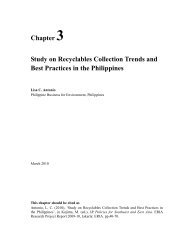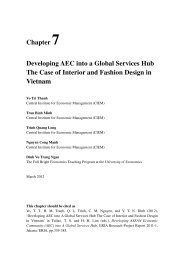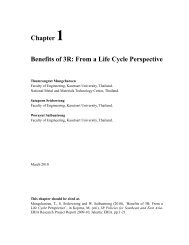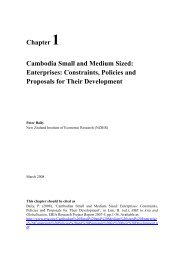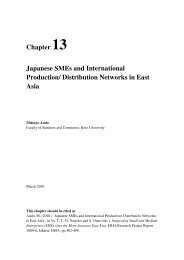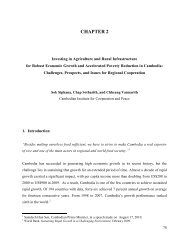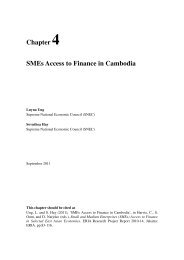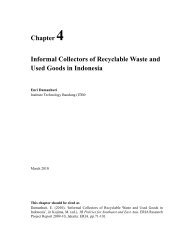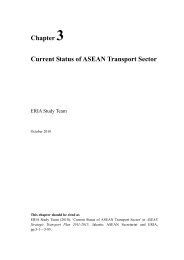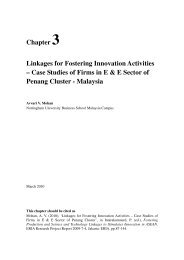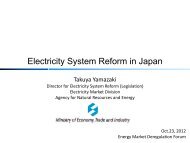Bank Efficiency, Regulation and Response to Crisis of ... - ERIA
Bank Efficiency, Regulation and Response to Crisis of ... - ERIA
Bank Efficiency, Regulation and Response to Crisis of ... - ERIA
You also want an ePaper? Increase the reach of your titles
YUMPU automatically turns print PDFs into web optimized ePapers that Google loves.
supported by the recent study by Gonzales (2009) that indicated a negative coefficientfor intensity <strong>of</strong> private moni<strong>to</strong>ring <strong>of</strong> financial markets. The negative coefficient in ourstudy indicates that private moni<strong>to</strong>ring does not yield a positive outcome for thefinancial markets in Southeast Asia. It is likely that more developed <strong>and</strong> well-diversifiedfinancial markets will rely heavily on the private sec<strong>to</strong>r <strong>to</strong> provide information on theactivities <strong>of</strong> the banks for deposi<strong>to</strong>rs <strong>and</strong> potential inves<strong>to</strong>rs. However, given the stage<strong>of</strong> growth <strong>of</strong> the financial markets in Southeast Asia <strong>and</strong> developing countries, privatemoni<strong>to</strong>ring might not produce a positive impact in these countries as compared <strong>to</strong> thosehosting well-developed financial markets. This result supports the views expressedduring both the recent Global Financial <strong>Crisis</strong> <strong>and</strong> the Asian <strong>Crisis</strong> concerning the moralhazard issues related <strong>to</strong> weak private sec<strong>to</strong>r moni<strong>to</strong>ring <strong>of</strong> the financial markets byrating agencies <strong>and</strong> private inves<strong>to</strong>rs.In contrast, the supervisory <strong>and</strong> regula<strong>to</strong>ry role <strong>of</strong> the central bank seems <strong>to</strong> produce apositive outcome in terms <strong>of</strong> improvements in the bank efficiency <strong>of</strong> the financialinstitutions in Southeast Asia. The RESTRICT variable that captures the restrictions onactivities that generate non-interest income is positive <strong>and</strong> statistically significant. Thissuggest that the regula<strong>to</strong>ry role <strong>of</strong> central banks in the region is crucial <strong>to</strong> bankefficiency. Moni<strong>to</strong>ring <strong>and</strong> regulating the balance sheet activities <strong>of</strong> banks tends <strong>to</strong>improve the productive performance <strong>of</strong> the banks in our sample. The coefficient on thebank supervisory variable (OFFICIAL) is also positive <strong>and</strong> statistically significant inour estimations. The transparency <strong>of</strong> the supervisory function <strong>and</strong> the <strong>of</strong>ficial authority<strong>of</strong> the supervisory activities <strong>of</strong> the central bank improve banking efficiency. Incomparison, the variable on the restriction <strong>of</strong> activities <strong>of</strong> non-interest income(RESTRICT) tends <strong>to</strong> have a higher coefficient in our estimation, indicating thatrestrictions on bank activities are associated with higher increments <strong>to</strong> bank efficiencycompared <strong>to</strong> the OFFICIAL variable.5. ConclusionThis paper studied the determinants <strong>of</strong> the technical efficiency <strong>of</strong> banks in SoutheastAsia using individual bank data from 1994 <strong>to</strong> 2008. The study controlled for bankheterogeneity <strong>and</strong> endogeneity issues by adopting the two-stage least square estimation305



